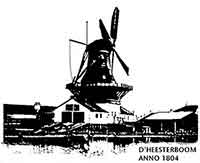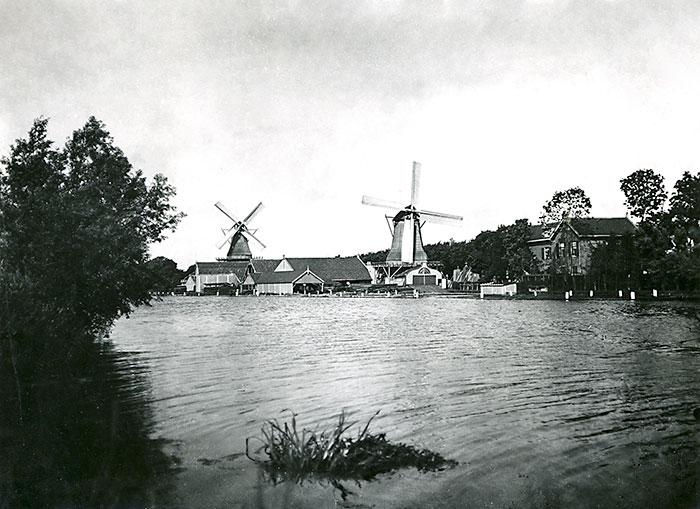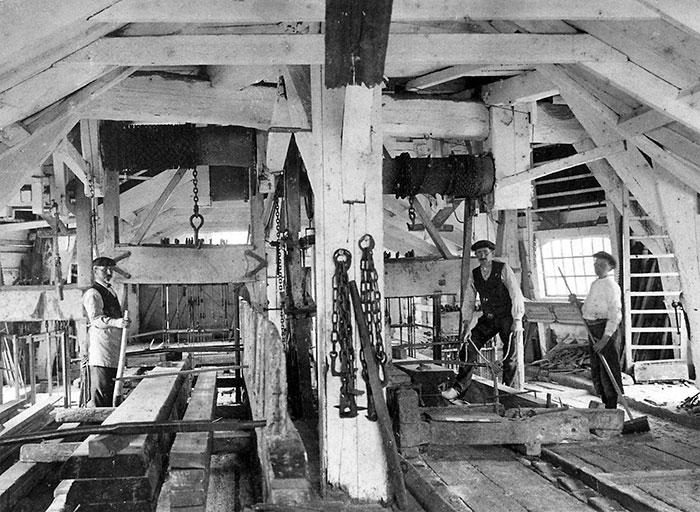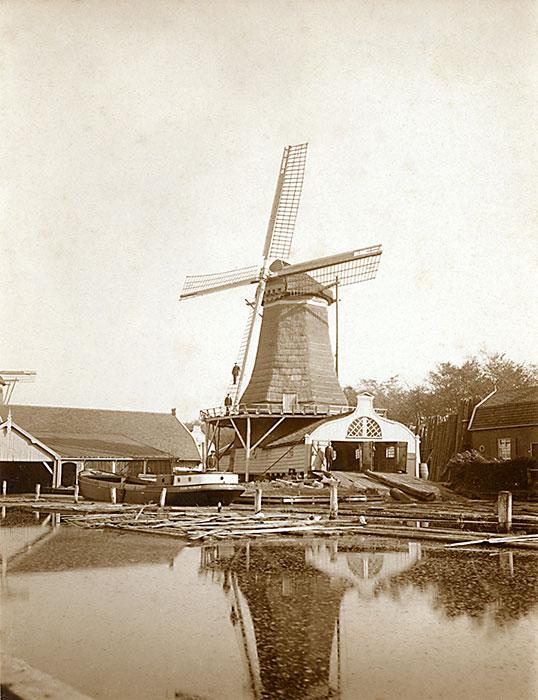History
Records show that before the year 1663 a sawmill was already located on the premises and trade in lumber was already taking place. The old mill with the name "de Ruyter" was located approximately on the same location as the present mill "de Heesterboom". The old "de Ruyter" mill was replaced in 1701 with a wooden octagonal frame type sawmill with the name
"de Valk".
In 1796 lumber tradesman Johannes van Hees bought "de Valk" with wharf, warehouse and houses located just beyond one of Leiden's city gates.
In the night of August 26th 1802 disaster struck in the form of lightning and the mill burned down. On January 27th 1803 the council of Leiden granted Johannes van Hees permission to build a new saw mill. The mill was completed in 1804 and christened “de Heesterboom”.
"de Valk".
In 1796 lumber tradesman Johannes van Hees bought "de Valk" with wharf, warehouse and houses located just beyond one of Leiden's city gates.
In the night of August 26th 1802 disaster struck in the form of lightning and the mill burned down. On January 27th 1803 the council of Leiden granted Johannes van Hees permission to build a new saw mill. The mill was completed in 1804 and christened “de Heesterboom”.
“de Heesterboom” and “de Eendracht” under full sail. Stichting Houtzaagmolen de Heesterboom
Johannes van Hees sold the mill in 1815 to Leendert Dorrepaal and Hendrik Meygaard who in turn resold the mill on to Cornelis Oudshoorn and Christian Jonathan Zaalberg in 1819. The latter built smaller type of sawmill in 1840 a bit further along the road. The mill bore the name of the youngest of his eight daughters "de Jong Paulina".
In 1848 Johannes Hendrikus Meerburg bought both sawmills,
"de Heesterboom" and "de Jonge Paulina". He already was the owner, through inheritance, of yet another sawmill a bit further along the same road. This merge brought to an end 90 years of competition. Coming from Leiden though the western city gate you could see in sequence: "de Jonge Paulina" approximately 100 meters further on "de Heesterboom" with two storage sheds and the miller’s house. And yet another 100 meters further on was
"de Eendracht" also in the midst of storage sheds, miller's house, coach house and boat house.
The interior of the demolished sawmill “de Eendracht” in approximately 1910. Similar to the present mill “de Heesterboom” this mill had three saw frames but however only two saw sledges. Stichting Houtzaagmolen de Heesterboom
Three mills for one lumber company was apparently a bit overdone because when Dirk Dirksz.Noordman acquired the lumber company in 1856 the windmill "de Jonge Paulina" had already disappeared. For a long time D.D Noordman Limited operated two wind sawmills, until electric operation replaced the traditional wind power in 1920. Windmill "de Heesterboom" was equipped in that year with an electric motor including metal parts in the saw frames and a new type of saw.
This turned out to be so lucrative that the decision was made in 1922 to dismantle "de Eendracht". Although it was also still possible to saw on wind power "de Heesterboom" rarely used this possibility after 1924.
Sawmill “de Eendracht” just before demolition in October 1922. On the 14 of December 1922 complete demolition was a fact. Stichting Houtzaagmolen de Heesterboom
Using the electric motor the mill continued sawing lumber until a crack in the crankshaft stopped the complete operation of the mill in 1953. After investigation it appeared that repair was not worthwhile and a sad end for the mill loomed. Fortunately the necessity for saving the unique sawmill was seen in time. Particularly because the complete interior, including old tools was still intact and present.
The exterior of the mill was restored in 1962 with subsidies from the province and city. Thanks to hard work and determination of the family Noordman and a group of enthusiastic volunteers the mill resumed operation and sawing lumber in the traditional way with the aid of the wind continues.
After five generations of Noordman possession the mill was handed over to a foundation with the name "Stichting Houtzaagmolen de Heesterboom" in 1993.
Between 1992 and 1994 the mill underwent a thorough maintenance program. The balcony, or boardwalk and two lumber storage sheds were renovated.
Another large project that was executed was placing an order for a new crankshaft with a company in the UK. The crankshaft was installed on February 21st 2005.
The exterior of the mill was restored in 1962 with subsidies from the province and city. Thanks to hard work and determination of the family Noordman and a group of enthusiastic volunteers the mill resumed operation and sawing lumber in the traditional way with the aid of the wind continues.
After five generations of Noordman possession the mill was handed over to a foundation with the name "Stichting Houtzaagmolen de Heesterboom" in 1993.
Between 1992 and 1994 the mill underwent a thorough maintenance program. The balcony, or boardwalk and two lumber storage sheds were renovated.
Another large project that was executed was placing an order for a new crankshaft with a company in the UK. The crankshaft was installed on February 21st 2005.




